Lei Deng
Bayesian Test-Time Adaptation for Vision-Language Models
Mar 12, 2025Abstract:Test-time adaptation with pre-trained vision-language models, such as CLIP, aims to adapt the model to new, potentially out-of-distribution test data. Existing methods calculate the similarity between visual embedding and learnable class embeddings, which are initialized by text embeddings, for zero-shot image classification. In this work, we first analyze this process based on Bayes theorem, and observe that the core factors influencing the final prediction are the likelihood and the prior. However, existing methods essentially focus on adapting class embeddings to adapt likelihood, but they often ignore the importance of prior. To address this gap, we propose a novel approach, \textbf{B}ayesian \textbf{C}lass \textbf{A}daptation (BCA), which in addition to continuously updating class embeddings to adapt likelihood, also uses the posterior of incoming samples to continuously update the prior for each class embedding. This dual updating mechanism allows the model to better adapt to distribution shifts and achieve higher prediction accuracy. Our method not only surpasses existing approaches in terms of performance metrics but also maintains superior inference rates and memory usage, making it highly efficient and practical for real-world applications.
Distance-Forward Learning: Enhancing the Forward-Forward Algorithm Towards High-Performance On-Chip Learning
Aug 27, 2024

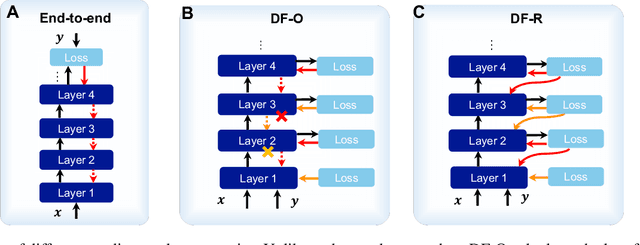

Abstract:The Forward-Forward (FF) algorithm was recently proposed as a local learning method to address the limitations of backpropagation (BP), offering biological plausibility along with memory-efficient and highly parallelized computational benefits. However, it suffers from suboptimal performance and poor generalization, largely due to inadequate theoretical support and a lack of effective learning strategies. In this work, we reformulate FF using distance metric learning and propose a distance-forward algorithm (DF) to improve FF performance in supervised vision tasks while preserving its local computational properties, making it competitive for efficient on-chip learning. To achieve this, we reinterpret FF through the lens of centroid-based metric learning and develop a goodness-based N-pair margin loss to facilitate the learning of discriminative features. Furthermore, we integrate layer-collaboration local update strategies to reduce information loss caused by greedy local parameter updates. Our method surpasses existing FF models and other advanced local learning approaches, with accuracies of 99.7\% on MNIST, 88.2\% on CIFAR-10, 59\% on CIFAR-100, 95.9\% on SVHN, and 82.5\% on ImageNette, respectively. Moreover, it achieves comparable performance with less than 40\% memory cost compared to BP training, while exhibiting stronger robustness to multiple types of hardware-related noise, demonstrating its potential for online learning and energy-efficient computation on neuromorphic chips.
A Mean Field Ansatz for Zero-Shot Weight Transfer
Aug 16, 2024



Abstract:The pre-training cost of large language models (LLMs) is prohibitive. One cutting-edge approach to reduce the cost is zero-shot weight transfer, also known as model growth for some cases, which magically transfers the weights trained in a small model to a large model. However, there are still some theoretical mysteries behind the weight transfer. In this paper, inspired by prior applications of mean field theory to neural network dynamics, we introduce a mean field ansatz to provide a theoretical explanation for weight transfer. Specifically, we propose the row-column (RC) ansatz under the mean field point of view, which describes the measure structure of the weights in the neural network (NN) and admits a close measure dynamic. Thus, the weights of different sizes NN admit a common distribution under proper assumptions, and weight transfer methods can be viewed as sampling methods. We empirically validate the RC ansatz by exploring simple MLP examples and LLMs such as GPT-3 and Llama-3.1. We show the mean-field point of view is adequate under suitable assumptions which can provide theoretical support for zero-shot weight transfer.
Unveiling the Potential of Spiking Dynamics in Graph Representation Learning through Spatial-Temporal Normalization and Coding Strategies
Jul 30, 2024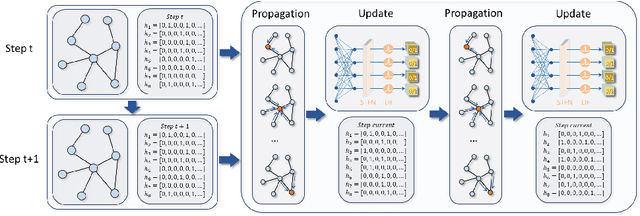
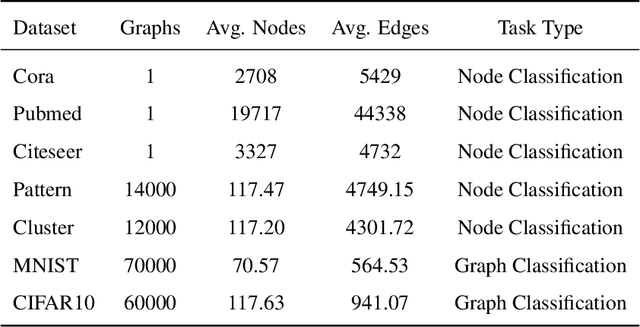

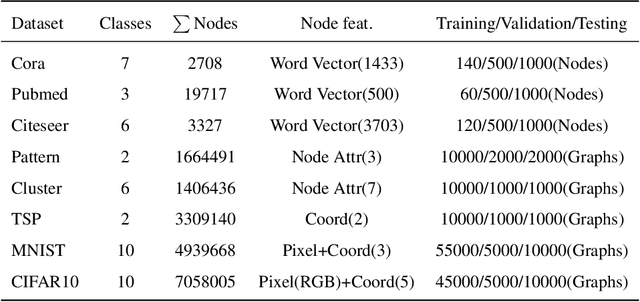
Abstract:In recent years, spiking neural networks (SNNs) have attracted substantial interest due to their potential to replicate the energy-efficient and event-driven processing of biological neurons. Despite this, the application of SNNs in graph representation learning, particularly for non-Euclidean data, remains underexplored, and the influence of spiking dynamics on graph learning is not yet fully understood. This work seeks to address these gaps by examining the unique properties and benefits of spiking dynamics in enhancing graph representation learning. We propose a spike-based graph neural network model that incorporates spiking dynamics, enhanced by a novel spatial-temporal feature normalization (STFN) technique, to improve training efficiency and model stability. Our detailed analysis explores the impact of rate coding and temporal coding on SNN performance, offering new insights into their advantages for deep graph networks and addressing challenges such as the oversmoothing problem. Experimental results demonstrate that our SNN models can achieve competitive performance with state-of-the-art graph neural networks (GNNs) while considerably reducing computational costs, highlighting the potential of SNNs for efficient neuromorphic computing applications in complex graph-based scenarios.
Retrieval Meets Reasoning: Dynamic In-Context Editing for Long-Text Understanding
Jun 18, 2024



Abstract:Current Large Language Models (LLMs) face inherent limitations due to their pre-defined context lengths, which impede their capacity for multi-hop reasoning within extensive textual contexts. While existing techniques like Retrieval-Augmented Generation (RAG) have attempted to bridge this gap by sourcing external information, they fall short when direct answers are not readily available. We introduce a novel approach that re-imagines information retrieval through dynamic in-context editing, inspired by recent breakthroughs in knowledge editing. By treating lengthy contexts as malleable external knowledge, our method interactively gathers and integrates relevant information, thereby enabling LLMs to perform sophisticated reasoning steps. Experimental results demonstrate that our method effectively empowers context-limited LLMs, such as Llama2, to engage in multi-hop reasoning with improved performance, which outperforms state-of-the-art context window extrapolation methods and even compares favorably to more advanced commercial long-context models. Our interactive method not only enhances reasoning capabilities but also mitigates the associated training and computational costs, making it a pragmatic solution for enhancing LLMs' reasoning within expansive contexts.
Beyond Scaling Laws: Understanding Transformer Performance with Associative Memory
May 14, 2024Abstract:Increasing the size of a Transformer model does not always lead to enhanced performance. This phenomenon cannot be explained by the empirical scaling laws. Furthermore, improved generalization ability occurs as the model memorizes the training samples. We present a theoretical framework that sheds light on the memorization process and performance dynamics of transformer-based language models. We model the behavior of Transformers with associative memories using Hopfield networks, such that each transformer block effectively conducts an approximate nearest-neighbor search. Based on this, we design an energy function analogous to that in the modern continuous Hopfield network which provides an insightful explanation for the attention mechanism. Using the majorization-minimization technique, we construct a global energy function that captures the layered architecture of the Transformer. Under specific conditions, we show that the minimum achievable cross-entropy loss is bounded from below by a constant approximately equal to 1. We substantiate our theoretical results by conducting experiments with GPT-2 on various data sizes, as well as training vanilla Transformers on a dataset of 2M tokens.
Understanding the Functional Roles of Modelling Components in Spiking Neural Networks
Mar 25, 2024Abstract:Spiking neural networks (SNNs), inspired by the neural circuits of the brain, are promising in achieving high computational efficiency with biological fidelity. Nevertheless, it is quite difficult to optimize SNNs because the functional roles of their modelling components remain unclear. By designing and evaluating several variants of the classic model, we systematically investigate the functional roles of key modelling components, leakage, reset, and recurrence, in leaky integrate-and-fire (LIF) based SNNs. Through extensive experiments, we demonstrate how these components influence the accuracy, generalization, and robustness of SNNs. Specifically, we find that the leakage plays a crucial role in balancing memory retention and robustness, the reset mechanism is essential for uninterrupted temporal processing and computational efficiency, and the recurrence enriches the capability to model complex dynamics at a cost of robustness degradation. With these interesting observations, we provide optimization suggestions for enhancing the performance of SNNs in different scenarios. This work deepens the understanding of how SNNs work, which offers valuable guidance for the development of more effective and robust neuromorphic models.
Enhancing Graph Representation Learning with Attention-Driven Spiking Neural Networks
Mar 25, 2024Abstract:Graph representation learning has become a crucial task in machine learning and data mining due to its potential for modeling complex structures such as social networks, chemical compounds, and biological systems. Spiking neural networks (SNNs) have recently emerged as a promising alternative to traditional neural networks for graph learning tasks, benefiting from their ability to efficiently encode and process temporal and spatial information. In this paper, we propose a novel approach that integrates attention mechanisms with SNNs to improve graph representation learning. Specifically, we introduce an attention mechanism for SNN that can selectively focus on important nodes and corresponding features in a graph during the learning process. We evaluate our proposed method on several benchmark datasets and show that it achieves comparable performance compared to existing graph learning techniques.
Extreme Video Compression with Pre-trained Diffusion Models
Feb 14, 2024Abstract:Diffusion models have achieved remarkable success in generating high quality image and video data. More recently, they have also been used for image compression with high perceptual quality. In this paper, we present a novel approach to extreme video compression leveraging the predictive power of diffusion-based generative models at the decoder. The conditional diffusion model takes several neural compressed frames and generates subsequent frames. When the reconstruction quality drops below the desired level, new frames are encoded to restart prediction. The entire video is sequentially encoded to achieve a visually pleasing reconstruction, considering perceptual quality metrics such as the learned perceptual image patch similarity (LPIPS) and the Frechet video distance (FVD), at bit rates as low as 0.02 bits per pixel (bpp). Experimental results demonstrate the effectiveness of the proposed scheme compared to standard codecs such as H.264 and H.265 in the low bpp regime. The results showcase the potential of exploiting the temporal relations in video data using generative models. Code is available at: https://github.com/ElesionKyrie/Extreme-Video-Compression-With-Prediction-Using-Pre-trainded-Diffusion-Models-
Extending Context Window of Large Language Models via Semantic Compression
Dec 15, 2023
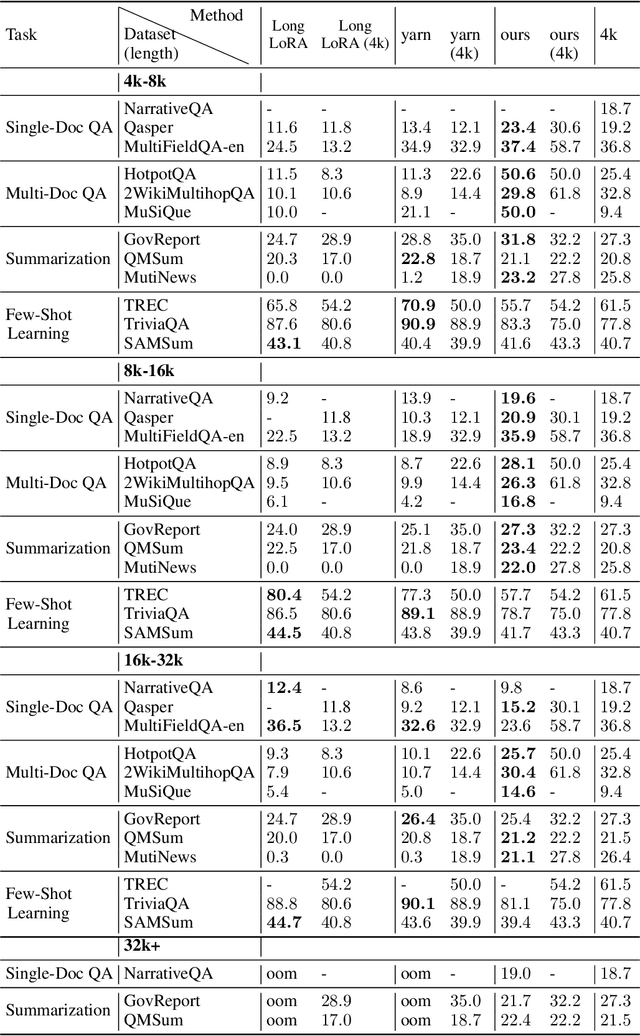
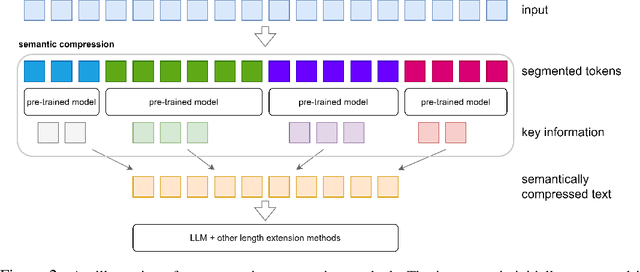
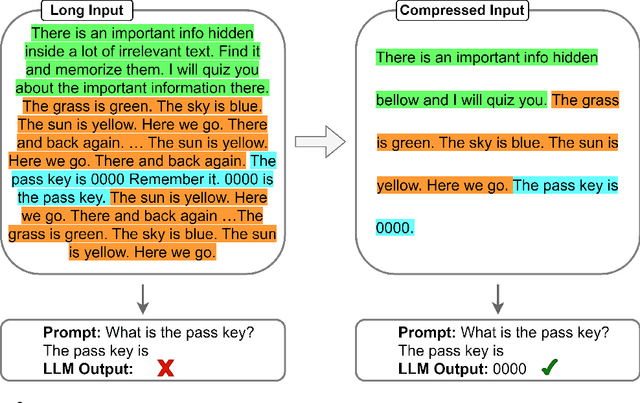
Abstract:Transformer-based Large Language Models (LLMs) often impose limitations on the length of the text input to ensure the generation of fluent and relevant responses. This constraint restricts their applicability in scenarios involving long texts. We propose a novel semantic compression method that enables generalization to texts that are 6-8 times longer, without incurring significant computational costs or requiring fine-tuning. Our proposed framework draws inspiration from source coding in information theory and employs a pre-trained model to reduce the semantic redundancy of long inputs before passing them to the LLMs for downstream tasks. Experimental results demonstrate that our method effectively extends the context window of LLMs across a range of tasks including question answering, summarization, few-shot learning, and information retrieval. Furthermore, the proposed semantic compression method exhibits consistent fluency in text generation while reducing the associated computational overhead.
 Add to Chrome
Add to Chrome Add to Firefox
Add to Firefox Add to Edge
Add to Edge